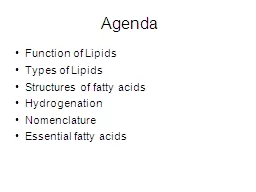

Structures of fatty acids Hydrogenation Nomenclature Essential fatty acids Agenda Functions Longterm storage Support organs Insulation Fat soluble vitamins A D E K Types Physical Property ID: 909513
Download Presentation The PPT/PDF document "Function of Lipids Types of Lipids" is the property of its rightful owner. Permission is granted to download and print the materials on this web site for personal, non-commercial use only, and to display it on your personal computer provided you do not modify the materials and that you retain all copyright notices contained in the materials. By downloading content from our website, you accept the terms of this agreement.
Slide1
Function of LipidsTypes of LipidsStructures of fatty acidsHydrogenationNomenclatureEssential fatty acids
Agenda
Slide2FunctionsLong-term ___ storageSupport organsInsulationFat soluble vitamins A, D, E, K
Slide3Slide4TypesPhysical PropertyChemical PropertyFatty acidsTriglyceridesPhospholipids
Cholesteryl ester
Vitamins
Slide5Slide6Fatty Acid Structure 1Chain length (chemical property)Melting/boiling point (physical property)Solubility in water (physical property)
Slide7Glycerol“backbone”
Poly-unsaturated fatty acid
Saturated fatty acid
Mono-unsaturated fatty acid
Fatty Acid Structure 2
Type of bonds (chem prop)
State/phase at room temperature (phys prop)
Slide8Slide9Fatty Acid Structure 3Trans- vs. Cis- fatty acidsState/phase at room temp
Slide10Slide11Review The four major classes of lipids are: fatty acids, ___ The different types of fatty acid are: _____________
The longer the fatty acid chain, the
stronger/weaker
the intermolecular force, and
higher/lower
the melting and boiling points.
What is the difference between fat and oil?
What chemical property contributes to the state of lipids?
Slide12HydrogenationHydrogenation: adding hydrogen double bonds single bondscis
double trans double
purpose: improve texture (liquid to solid) and shelf-life (less likely to oxidize)
Slide13Hydrogenation
Slide14Rarely found in natureFats and oils that may contain a high proportion of trans-fatty acids are: Margarine Frying Fats
Shortening
H
H
Partial Hydrogenation
Slide15Slide16Nomenclatureα Naming System: 18:3 cis-9, cis-12, cis-15
ω
Naming System: omega-3
Common Name:
linolenic
acid (
α
-
linolenic
acid)
How many carbons in length
How many double bonds
Where are the double bonds
Cis
or trans double bonds
Slide17Stearic Acid
Saturated Fatty Acids =
No Double Bonds
Rumenic
Acid
Linoleic
Acid
Polyunsaturated
Fatty Acids =
More than One
Double Bond
Oleic Acid
Elaidic
Acid
Monounsaturated Fatty Acids =
One Double Bond
H
H
H
H
Slide18Stearic Acid
18:0
Saturated Fatty Acids =
No Double Bonds
Rumenic Acid
18:2 cis-9, trans-11
Linoleic
Acid
18:2 cis-9 cis-12
Polyunsaturated
Fatty Acids =
More than One
Double Bond
Oleic Acid
18:1 cis-9
Elaidic Acid
18:1 trans-9
Monounsaturated Fatty Acids =
One Double Bond
H
H
H
H
Slide19Nomenclature Name each of the following by its α and ω
names (or draw its molecular structure)
cis9-16:1
cis5, cis8, cis11, cis14-20:4
Slide20Slide21Name These Fatty Acids
Slide22Properties of Triglycerides
Can you explain the physical properties in terms of the chemical structures of the fatty acids?
Slide23Does the human body use lipids from our diet as the way they are?No, lipids are broken down into smaller units (fatty acids & glycerol)Once broken down and absorbed, then can be restructured/changed into forms the body can use
Slide24Essential Fatty AcidsThe body cannot synthesize double bonds in the ω-3 and
ω
-6
positions
The body uses the essential fatty acids to make nonessential fatty acids (EPA, DHA, ACA) and other lipid-like substances (
eicosanoids
)
α
-Linolenic Acid
Linoleic Acid
Omega 3
Omega 6
Slide25Elongation & Desaturation
Slide26EPA & DHAHormones in the immune and cardiovascular systems
Biological membrane in nerve tissues and retina
Necessary for epithelial cell function
Involved in gene regulation
Docosahexaenoic acid (DHA)
Eicosapentaenoic
acid
(EPA)
Slide27Conditionally Essential Fatty AcidsInfants lack the enzymes to make DHA from linoleic and linolenic acids
Slide28Dietary SourcesLinoleic acid: walnuts, seeds, oil (soybean, corn, etc)Linolenic acid: walnuts, oil (soybean, canola, flaxseed)Plentiful in fatty fish and seafoodSmall amounts in meat and eggs
Slide29Essential FA DeficiencyRare because we have stored adipose tissuespatients receiving poor nutritional carediseases that disrupt lipid absorption/utilization
Irritated and flaky skin
Gastrointestinal problems
Impaired immune function
Wound healing slowly
Slow growth in children
Slide30Pop Quiz The body uses 1 as the main energy source. Excess ___ (same as above) is stored as
2
in the
3
and muscles.
A(n)
4
, composed of 1 glycerol and
5
fatty acids, is the long-term storage form that stores almost three times as much energy.
The body can convert fat into
6
for energy when it is necessary.